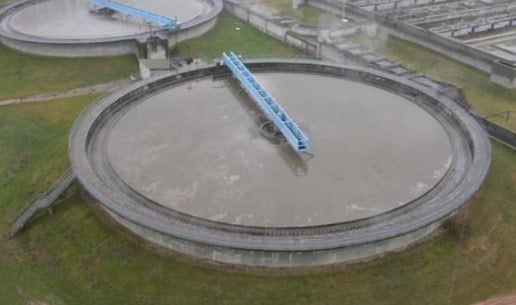Different Types of Sedimentation Tanks used in Water Treatment
A sedimentation tank is structure in which wastewater is filled and stored for some time to remove the suspended particles present in the water. These particles may settle at the bottom of the tank and are removed by using scrapers. If the suspended particles have low specific gravity than water, they settle at the top of the tank.
Types of Sedimentation Tanks
Depending upon various factors sedimentation tanks are classified as follows.
1. Based on methods of operation
a. Fill and draw type tank
b. Continuous flow type tank
2. Based on shape
a. Circular tank
b. Rectangular tank
c. Hopper bottom tank
3. Based on location
a. Primary tank
b. Secondary tank

Types of Sedimentation Tanks based on Methods of Operation
Fill and Draw Type Sedimentation Tank
In case of fill and draw type sedimentation tank, water from inlet is stored for some time. The time may be 24 hours. In that time, the suspended particles are settled at the bottom of the tank. After 24 hours, the water is discharged through outlet.
Then settled particle are removed. This removal action requires 6-12 hours. So, one complete action of sedimentation requires 30-40 hours in case of fill and draw type sedimentation tank.

Continuous Flow Type Sedimentation Tank
In this case, water is not allowed to rest. Flow always takes place but with a very small velocity. During this flow, suspended particles are settle at the bottom of the tank. The flow may be either in horizontal direction or vertical direction.

Horizontal flow type sedimentation tank
These tanks generally in rectangular shape. They have more length twice its width. Because they need to flow more distance to settle all suspended particles. The maximum permissible velocity in this case is 0.3m/sec.
Vertical flow type sedimentation tank
The vertical flow type sedimentations tanks are generally in circular shape and flow takes place in vertical direction. Hopper bottom is provided at the bottom of the tank to dispose the collected sludge.
Types of Sedimentation Tanks based on Shape
Circular Tank
Circular sedimentation tanks are preferred for continuous vertical flow type sedimentation tanks. In this case influent is sent through central pipe of the tank and radial flow takes place.
Mechanical sludge scrappers are provided to collect the sludge and collected sludge is carried through sludge pipe provided at the bottom. But circular tanks are uneconomical as compared to rectangular tanks but they have high clarification efficiency.

Rectangular Tank
Rectangular sedimentation tanks are mostly preferred sedimentation tanks and are used widely. The flow takes place in horizontal direction that is length wise in rectangular tanks. Sometimes baffle walls are provided for rectangular tank to prevent short circuiting.
Maintenance costs are low in case of rectangular sedimentation tanks. They are also suitable for large capacity plants.

Hopper Bottom Tank
In case of hopper bottom tank, a deflector box is located at the top which deflects the influent coming from central pipe to downwards. Sludge is collected at the bottom and it is disposed through sludge pump.

Types of Sedimentation Tanks based on Location
Primary Sedimentation Tank
Primary sedimentation tank is a normal sedimentation tank in which water is stored at rest for some time and sludge collected at bottom and oily matter collected at top are removed. After primary sedimentation process the wastewater is discharged into aerobic filter where activated sludge process take place.
Secondary Sedimentation Tank
After activated sludge process the wastewater enters secondary sedimentation tank in which suspended particles contains microbes are removed and are reflected towards aerobic filter to maintain high microbe concentration in aerobic filter.
 

No comments:
Post a Comment